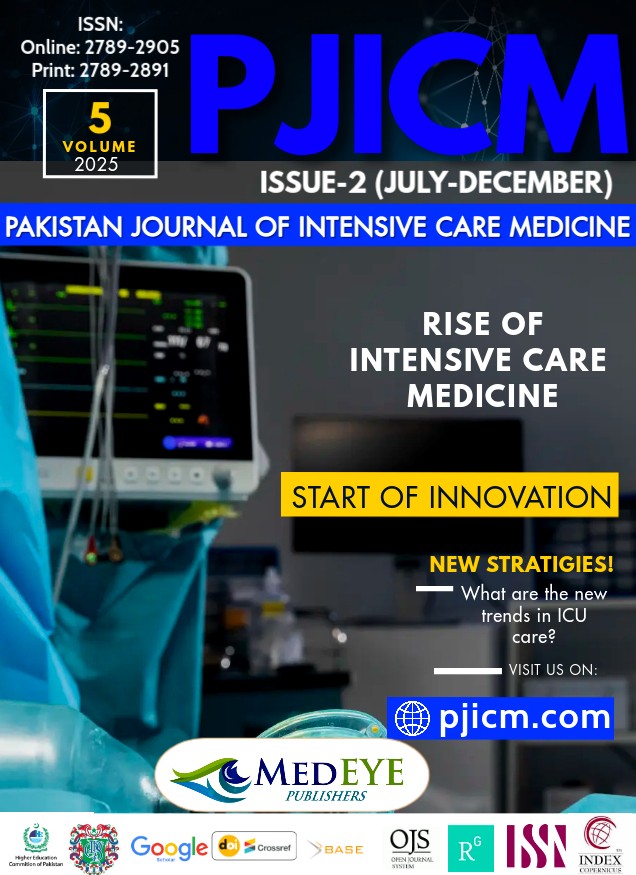FREQUENCY OF HYPOKALEMIA IN CHILDREN WITH ACUTE DIARRHEA PRESENTING TO SAIDU GROUP OF TEACHING HOSPITAL
DOI:
https://doi.org/10.54112/pjicm.v5i02.194Keywords:
Hypokalaemia, Acute Diarrhoea, Paediatrics, Electrolyte ImbalanceAbstract
Background: Acute diarrhea remains one of the leading causes of morbidity and mortality among children in developing countries. Electrolyte disturbances, particularly hypokalemia, are common complications that can exacerbate disease severity and increase the risk of adverse outcomes. Objective: To determine the frequency of hypokalemia in children presenting with acute diarrhea at Saidu Group of Teaching Hospital. Study Design: Descriptive cross-sectional study. Setting: Department of Pediatrics, Saidu Group of Teaching Hospital, Swat, Pakistan. Duration of Study: 06-02-2025--06-05-2025. Methods: A total of 145 children aged 1–8 years presenting with acute diarrhea were enrolled. Acute diarrhea was defined as more than three watery stools per 24 hours for up to 10 days, accompanied by fever (>37.2°C) and abdominal pain. Serum potassium levels were measured, and hypokalemia was defined as a potassium concentration <3.5 mmol/L. Data were analyzed using SPSS version 21. Descriptive statistics were calculated, and associations were assessed using chi-square tests; p ≤ 0.05 was considered significant. Results: The mean age of participants was 3.55 ± 2.37 years, with males comprising 58.6% (n = 85). The overall frequency of hypokalemia was 45.5% (n = 66), and the mean serum potassium level was 3.65 ± 1.23 mmol/L. Hypokalemia was significantly associated with younger age (p = 0.02) and a longer duration of diarrhea (>15 days) (p = 0.03). Conclusion: Hypokalemia was observed in nearly half of the children presenting with acute diarrhea, with a higher prevalence in younger patients and those with prolonged illness. Early recognition and prompt correction of hypokalemia are essential to reduce complications and improve clinical outcomes.
References
Guarino A, Aguilar J, Berkley J, Broekaert I, Vázquez-Frías R, Holtz L, et al. Acute gastroenteritis in children of the world: what needs to be done? J Pediatr Gastroenterol Nutr. 2020;70(5):694–701. https://doi.org/10.1097/MPG.0000000000002669
Florez ID, Nino-Serna LF, Beltran-Arroyave CP. Acute infectious diarrhea and gastroenteritis in children. Curr Infect Dis Rep. 2020;22(2):4. https://doi.org/10.1007/s11908-020-0713-6
da Cruz Gouveia MA, Lins MT, da Silva GA. Acute diarrhea with blood: diagnosis and drug treatment. J Pediatr (Rio J). 2020;96(S1):20–28. https://doi.org/10.1016/j.jped.2019.08.006
Huang R, Xing HY, Liu HJ, Chen ZF, Tang BB. Efficacy of probiotics in the treatment of acute diarrhea in children: a systematic review and meta-analysis of clinical trials. Transl Pediatr. 2021;10(12):3248–3260. https://doi.org/10.21037/tp-21-511
Natnael T, Lingerew M, Adane M. Prevalence of acute diarrhea and associated factors among children under five in semi-urban areas of northeastern Ethiopia. BMC Pediatr. 2021;21(1):290. https://doi.org/10.1186/s12887-021-02762-5
Bardhan PK, Das R, Nahar B, Haque MA, Sobi RA, Sultana AA, et al. Assessing safety and efficacy of a novel glucose-free amino acid oral rehydration solution for watery diarrhea management in children: a randomized, controlled, phase III trial. EClinicalMedicine. 2024;72:102630. https://doi.org/10.1016/j.eclinm.2024.102630
Lo Vecchio A, Conelli ML, Guarino A. Infections and chronic diarrhea in children. Pediatr Infect Dis J. 2021;40(7):e255–e258. https://doi.org/10.1097/INF.0000000000003182
Lakshminarayanan S, Jayalakshmy R. Diarrheal diseases among children in India: current scenario and future perspectives. J Nat Sci Biol Med. 2015;6(1):24–28. https://doi.org/10.4103/0976-9668.149073
Wu CJ, Li CS. The impact of iatrogenic hypernatremia on the prognosis of critical patients. Zhongguo Wei Zhong Bing Ji Jiu Yi Xue. 2009;21(8):474–477.
Anigilaje EA. Management of diarrhoeal dehydration in childhood: a review for clinicians in developing countries. Front Pediatr. 2018;6:28. https://doi.org/10.3389/fped.2018.00028
Arif M, Afridi AS, Ali F, Banuri S, Salman M, Khan M. Frequency of hyponatremia and hypokalemia in children with acute diarrhea. Pak J Med Health Sci. 2021;15(9):2565–2567. https://doi.org/10.53350/pjmhs211592565
Karim R, Afridi JK, Zaman A, Zada U, Younas M. To determine the frequency of hypokalemia in children with persistent diarrhoea. Khyber J Med Sci. 2015;8(3):418–423. DOI not available.
Rehman MU, Khalid A, Khan MA, Khan Z, Sohail A, Khan I. Frequency of hypokalemia in malnourished children with acute diarrhea. Med Forum. 2021;32(2):33–36.
Ahmad N, Chaudhary AR, Usman M, Ayub MR. Frequency of hypokalemia in pediatric ICU patients with diarrhea and their outcome in a tertiary care pediatric hospital in Lahore, Pakistan. Prof Med J. 2025;32(10):1388–1395. https://doi.org/10.29309/TPMJ/2025.32.10.8349
Mushtaq A, Naz S, Shehram M, Lodhi AM. Frequency of clinical presentations of hypokalemia in diarrhoea. Pak J Med Health Sci. 2020;14(1):309–311.
Abadin MZ, Iftikar M, Arshad N, Mahmood Z, Tahira B, Shafiq M, et al. Frequency of electrolyte imbalance in children with pediatric acute diarrhea. Esculapio J. SIMS. 2020;16(3):23–27. https://doi.org/10.51273/esc20.251635
Downloads
Published
How to Cite
Issue
Section
License
Copyright (c) 2025 A JAHANGIR , IU HAQ

This work is licensed under a Creative Commons Attribution-NonCommercial 4.0 International License.












